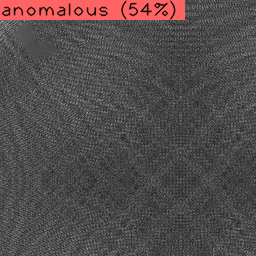はじめに
前回は anomalib をカスタムデータで学習させる方法について説明しました。
今回は、推論プログラムを使いやすいように変更していきます。
前提条件
前提条件は以下の通りです。
- torch == 1.12.1+cu113
- pytorch_lightning == 1.9.5
推論の前に
カメラ映像を OpenCV で読み取り、推論するためには pytorch_lightning ではなく、torch を使用する必要があります。
pytorch_lightning は、推論するためにデータローダーを構築する必要があるので、今回は使用しません。
torch モデルを学習
まずは、src/anomalib/models/padim/config.yaml を編集します。
dataset:
name: custom
format: folder
path: ./datasets/MVTec/custom
# category: custom
normal_dir: train/good
normal_test_dir: test/good
abnormal_dir: test/defect
mask_dir: null
extensions: null
# task: segmentation
task: classification
train_batch_size: 8
eval_batch_size: 8
num_workers: 2
image_size: 256 # dimensions to which images are resized (mandatory)
center_crop: null # dimensions to which images are center-cropped after resizing (optional)
normalization: imagenet # data distribution to which the images will be normalized: [none, imagenet]
transform_config:
train: null
eval: null
test_split_mode: from_dir # options: [from_dir, synthetic]
test_split_ratio: 0.1 # fraction of train images held out testing (usage depends on test_split_mode)
val_split_mode: same_as_test # options: [same_as_test, from_test, synthetic]
val_split_ratio: 0.1 # fraction of train/test images held out for validation (usage depends on val_split_mode)
tiling:
apply: false
tile_size: null
stride: null
remove_border_count: 0
use_random_tiling: False
random_tile_count: 16
model:
name: padim
# backbone: resnet18
backbone: wide_resnet50_2
pre_trained: true
layers:
- layer1
- layer2
- layer3
normalization_method: min_max # options: [none, min_max, cdf]
metrics:
image:
- F1Score
- AUROC
pixel:
- F1Score
- AUROC
threshold:
method: adaptive #options: [adaptive, manual]
manual_image: null
manual_pixel: null
visualization:
show_images: False # show images on the screen
save_images: True # save images to the file system
log_images: True # log images to the available loggers (if any)
image_save_path: null # path to which images will be saved
mode: full # options: ["full", "simple"]
project:
seed: 42
path: ./results
logging:
logger: [] # options: [comet, tensorboard, wandb, csv] or combinations.
log_graph: false # Logs the model graph to respective logger.
optimization:
# export_mode: null # options: torch, onnx, openvino
export_mode: torch
# PL Trainer Args. Don't add extra parameter here.
trainer:
enable_checkpointing: true
default_root_dir: null
gradient_clip_val: 0
gradient_clip_algorithm: norm
num_nodes: 1
devices: 1
enable_progress_bar: true
overfit_batches: 0.0
track_grad_norm: -1
check_val_every_n_epoch: 1 # Don't validate before extracting features.
fast_dev_run: false
accumulate_grad_batches: 1
max_epochs: 1
min_epochs: null
max_steps: -1
min_steps: null
max_time: null
limit_train_batches: 1.0
limit_val_batches: 1.0
limit_test_batches: 1.0
limit_predict_batches: 1.0
val_check_interval: 1.0 # Don't validate before extracting features.
log_every_n_steps: 50
accelerator: cpu # <"cpu", "gpu", "tpu", "ipu", "hpu", "auto">
strategy: null
sync_batchnorm: false
precision: 32
enable_model_summary: true
num_sanity_val_steps: 0
profiler: null
benchmark: false
deterministic: false
reload_dataloaders_every_n_epochs: 0
auto_lr_find: false
replace_sampler_ddp: true
detect_anomaly: false
auto_scale_batch_size: false
plugins: null
move_metrics_to_cpu: false
multiple_trainloader_mode: max_size_cycle
74 行目の export_mode を null から torch へ変更しました。
学習コマンド
学習コマンドは同じです。
python .\tools\train.py --model padim推論コマンド
python tools/inference/torch_inference.py \
--config src/anomalib/models/padim/config.yaml \
--weights results/padim/custom/run/weights/torch/model.pt \
--input ./datasets/MVTec/custom/test/defect/1.png \
--output results/padim/custom/test/1_result.png \
--device cpu \
--task classification \
--show False \
--visualization_mode simple上記を実行すると、pytorch_lightning と同じ結果が得られます。

推論プログラムの作成
torch_inference.py をコピーして custom_inference.py とします。
"""Anomalib Torch Inferencer Script.
This script performs torch inference by reading model weights
from command line, and show the visualization results.
"""
# Copyright (C) 2022 Intel Corporation
# SPDX-License-Identifier: Apache-2.0
from argparse import ArgumentParser, Namespace
import cv2
import torch
from anomalib.deploy import TorchInferencer
# from anomalib.post_processing import Visualizer
def infer(args: Namespace) -> None:
"""Infer predictions.
Show/save the output if path is to an image. If the path is a directory, go over each image in the directory.
Args:
args (Namespace): The arguments from the command line.
"""
torch.set_grad_enabled(False)
# Create the inferencer and visualizer.
inferencer = TorchInferencer(path=args.weights, device=args.device)
# visualizer = Visualizer(mode=args.visualization_mode, task=args.task)
image = cv2.imread(args.input)
image = cv2.cvtColor(image, cv2.COLOR_BGR2RGB)
predictions = inferencer.predict(image=image)
print("pred_score: ", predictions.pred_score, "pred_label: ", predictions.pred_label)
# output = visualizer.visualize_image(predictions)
# if args.output:
# file_path = generate_output_image_filename(input_path=args.input, output_path=args.output)
# visualizer.save(file_path=file_path, image=output)
# Show the image in case the flag is set by the user.
if args.show:
# visualizer.show(title="Output Image", image=output)
image = cv2.cvtColor(image, cv2.COLOR_RGB2BGR)
cv2.imshow("frame", image)
cv2.waitKey(0)
cv2.destroyAllWindows()
if __name__ == "__main__":
args = ArgumentParser().parse_args()
args.input = "./datasets/MVTec/custom/test/defect/1.png"
args.config = "src/anomalib/models/padim/config.yaml"
args.weights = "results/padim/custom/run/weights/torch/model.pt"
# args.output = "results/padim/custom/test/1_result.png"
args.device = "cpu"
args.show = True
args.visualization_mode = "simple"
args.task = "classification"
infer(args=args)
上記を実行すると、以下の出力が得られます。
pred_score: 0.5353217090536091 pred_label: Anomalousおわりに
今回は anomalib の推論プログラムを変更しました。
これでカメラから取得したデータをそのまま推論し、結果を数値で得ることができるようになりました。



コメント